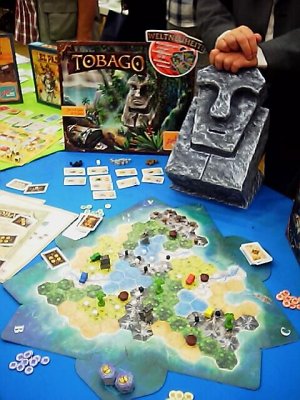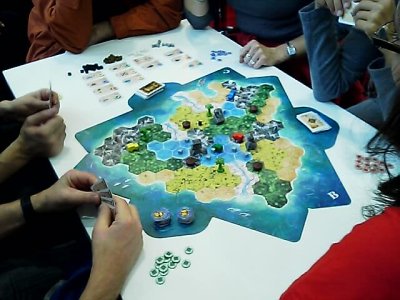![[Headline]](../technik/sonstige/headtran.gif)
![[Headline]](../technik/sonstige/headtran.gif)
![[IMAGE]](../bilder/tobago1.jpg) |
Author: Publisher: No. of Players: |
![[IMAGE]](../technik/box/rot/rot-5.gif) ![[IMAGE]](../technik/box/gelb/gelb-10.gif) ![[IMAGE]](../technik/box/grun/grun-5.gif) ![[IMAGE]](../technik/box/pink/pink-7.gif) ![[IMAGE]](../technik/box/blau/blau-8.gif) |
|
Having seen a beautiful display at the news show of the SPIEL 09, I simply had to have a look at Tobago from ZOCH. This German publisher is well known amongst the ranks of gamers for his beautiful and atmospheric games which often offer unusual playing mechanisms. A splendid example for their high-class games is the SPIEL DES JAHRES awards winner Niagara, and today I would like to present you a game which seems to be going well on the same track, possibly even reaching out to get a chance to win Germany's most popular games award. Tobago is a game about treasure hunters on a lonely island. Coming in the regular square-sized ZOCH box, the players are invited to discover a great batch of nicely designed playing components: three parts of the double sided gameboard, wooden playing pieces of All-Terrain-Vehicles (ATV), palm trees and huts, and - last but not least - three stunningly nice miniature statues which were built long ago by the original inhabitants of the island. The topic of the game actually might suggest some kind of adventure boardgame with the players collecting equipment and surviving perils, but I was quite surprised to see that Tobago by no means works similar than GOLDSIEBER's Goldland, but instead it is a rather entertaining deduction game with a quite unique playing mechanism. Thus, during the course of the game the players constantly will cruise from one end to the island to the other, trying to participate as well as possible in the raising of treasures. However, ever new treasures are appearing, so that the winning of the game is not just based on a simplistic "most treasures wins" strategy. Before I tell you more about the raising of treasures, let us first have a closer look at the topography of the island of Tobago. Made up of a three-part gameboard, the island changes with every game, but regardless of the mounting of the board always a total of six different kinds of landscapes can be found: beaches, palm forests, scrublands, mountains, streams and sweetwater seas. At the beginning of the game the players also add three statues, three palm trees and four huts as additional landmarks at randomly chosen spaces of the island, and so the players will find a new layout of the island with every game. Starting with their ATV on a space of their choice, the players may opt to use their turn to move their ATV for up to three legs, with each leg of their movement consisting either of a change of terrain or by moving as far as they desire on the same kind of terrain. Depending on the island layout and the chosen course, the ATV can be moved pretty far or only for minor steps, but much depends on a player's keen eye to chose a movement path best matching the current opportunities on the gameboard.  It is the aim of the players to get their ATV to spaces where treasures are buried, and it is the question how to find out where a treasure is buried on which the main playing mechanism of the game is focused. For this reason each of the players possesses a hand of clue cards which form fragments of a treasure map, and these clue cards usually refer to one type of landscape or landmark on the island. Thus, a clue card may tell that a treasure lies buried NOT in the mountains, adjacent to a hut, at the beach, within one or two spaces of a statue etc. All clue cards have in common that no single space containing a treasure can be identified with a card, and so several clue cards need to be combined until one (and only one) space can be identified where a treasure is buried. During his turn a player may refrain from moving his ATV and instead play one of the clue cards from his hand, and he may add his clue card to one of four different treasure maps. As indicated, there will always be four treasures available simultaneously, and so the players jointly can build at several maps in order to narrow down the possibilities where a treasure may be hidden. Whenever a player adds a clue card to a treasure map he may place a compass token of his colour on the clue card to indicate that he has placed the card, but a clue may only be placed under the condition that it will narrow down the number of available treasure sites while at the same time not preventing the raising of a treasure completely. As the possible locations of a treasure become more and more restricted there comes a time when a set of wooden cubes marking possible treasure positions comes into play. Thus, each available treasure map is assigned a number of matchingly coloured wooden cubes, and when the time has come that the position of a treasure has been narrowed down enough all remaining possible treasure sites will be marked with wooden cubes. From now on every player who adds a clue to that specific treasure map has to remove all cubes from spaces where the treasure cannot be hidden anymore, and so the final positioning of a treasure will be visible once only one cube of the treasure's colour is left on the gameboard. Now the players will use their ATV to get to the treasure's position, and the first player to arrive will be allowed to put one of his compass tokens at the bottom of the treasure map and to proclaim the treasure to be raised. This starts the treasure distribution procedure, and now the player who is raising the treasure and those players who contributed cards to the particular treasure map will participate in the distribution of the treasure. However, once again author Bruce Allen has refrained from using a simple distribution procedure, but instead the players will be put to a small speculative challenge. Thus, each player is allowed to draw as many treasure cards from the mixed pile as he has compass tokens at the treasure map, but the players are not allowed to keep these cards but they just get a chance to look at their values. Then all cards are collected, and an additional card is added from the pile treasure cards. These cards are shuffled and the first card is revealed. Following the order of the compass tokens at the treasure map from top to bottom, the players now have a chance either to claim that treasure card or to pass. If a player passes the next player is asked, and if nobody wants the treasure it is discarded. If a player decides to keep the treasure when he is asked, he takes back his compass token and gets the treasure card. The treasure distribution then continues with the remaining players, until either all players have received a treasure for each of their compass tokens or until the treasure cards are used up. As you can see, the players retain a minimum degree of control as to which treasure cards they might get, and their partial knowledge about the whole haul of treasure cards gives them some indication whether a treasure is worth keeping or if it should be passed on. Such a mechanism gains additional thrill if there is a risk involved, and in Tobago there is a risk that the players actually might reveal a cursed treasure. If such a card turn up, all remaining treasure cards for the current distribution are discarded, and furthermore each player who has at least one compass token left on the treasure map must discard his most valuable treasure card. However, the risk of such a malady can be avoided by players possessing an Amulet, and so an Amulet can be discarded instead of the valuable treasure card. Amulets are relics of the former inhabitants of Tobago, and they appear whenever a Treasure is raised. At that instance an Amulet is placed in the line of sight of each of the three statutes, appearing at the last island space before the ocean. After the three Amulets are placed, the statues mysteriously start to turn, changing their orientation by 60 degree and waiting for the next treasure to be raised. In a way, the Amulets are a rather Omni potential cure to different situations in the game, since apart from their curse-avoidance-functions they can also be discarded to play an additional clue card, give the ATV an additional move, exchange the player's hand of clue cards or even to remove a treasure cube. Especially this last option is rather powerful when a treasure's position has been narrowed down enough to gain decisive influence on its final position, and thus the players should not underestimate the usefulness of the Amulets. The game finishes on a more traditional way simply when the deck of treasure cards runs out, and the player with the most valuable treasure cards will have won. However, as you should have seen during this short description, the task of getting the most valuable cards is a matter of timing, generating possibilities and speculating on treasure cards, and thus the idea might come up that it might be much more important just to play as many clue cards as possible than to actively raise a treasure. However, such a strategy does not seem to yield success, since it disregards the fact that the distribution of treasure cards upon the raising of a treasure depends on a "last-served-first" order, thus giving the player who raises a treasure a first pick on the appearing treasure cards. This is a position of considerable power, and thus players who randomly add clue cards in the hope of getting to participate more often than others usually will only receive less valuable treasure cards. I think this observation is rather important since it ensures that the game cannot be highjacked by "strategists" who claim to have seen through the game's basic principles. Quite the opposite, the game gently pushes the players to actively find the best possibilities by playing clue cards and moving their ATV, and coupled with the numerous uses of the Amulets the players are presented a rather entertaining and challenging playing mechanism. Coupled with ZOCH's typical rather attractive graphic design, Tobago is a great family game and for me a hot candidate for the next Spiel des Jahres.  | ||
|
| |

Looking for this game? Visit Funagain Games! |
|
|
| |
|
Impressum / Contact Info / Disclaimer Kulkmann@aol.com
Copyright © 2009 Frank Schulte-Kulkmann, Essen, Germany | |